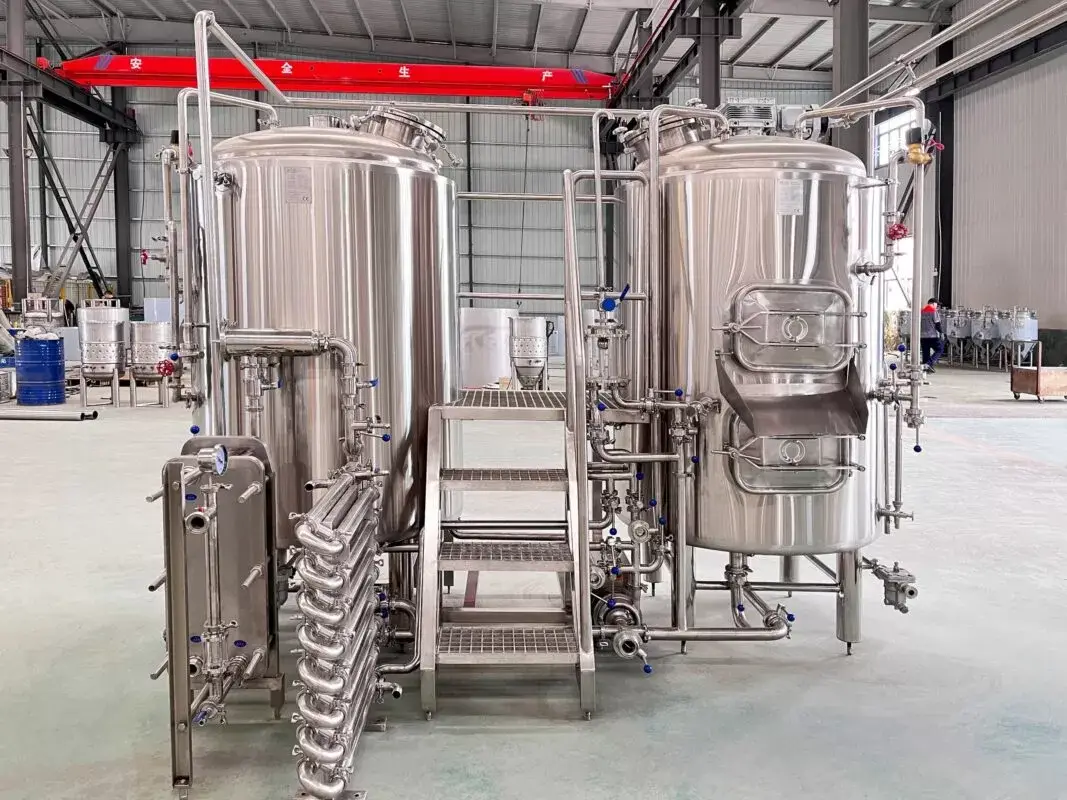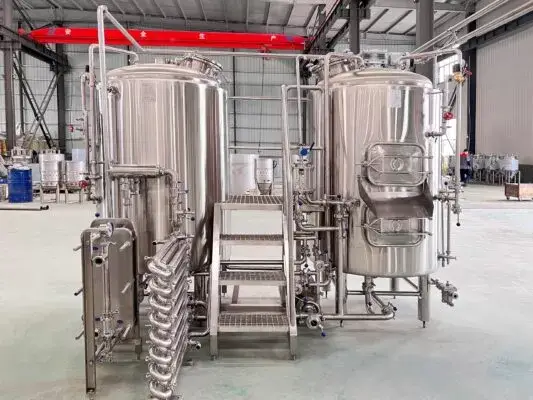알코올 양조 장비 맥주, 와인, 증류주 및 기타 알코올 음료를 생산하려면 특수 장비가 필요합니다. 이 가이드는 주요 장비 유형, 시스템 선택 및 설치 시 고려 사항, 공급자에 대한 요약을 제공합니다.
알코올 양조 장비 유형
| 장비 | 설명 |
|---|---|
| 양조 주전자 | 곡물을 으깨고 맥즙을 끓이기 위한 가열 용기. 스테인레스 스틸 또는 구리로 제공됩니다. 크기는 5배럴부터 20배럴까지 다양합니다. |
| 발효 탱크 | 알코올 발효를 제어할 수 있는 스테인리스 스틸 또는 플라스틱 탱크. 배치 볼륨에 따라 크기가 결정되며 일반적으로 10배럴에서 수천 배럴까지입니다. |
| 온도 제어 | 탱크 온도를 조절하는 글리콜 냉각기와 같은 가열 및 냉각 요소입니다. |
| 배관, 밸브, 펌프 | 액체 이송, 흐름 조절, 장비 청소를 위한 하드웨어입니다. 수동 또는 자동. |
| 프로세스 제어 | 양조를 모니터링하고 제어하는 센서, 자동화 장비 및 소프트웨어입니다. |
| 병입/통조림 라인 | 고속 기계는 병이나 캔을 채우거나 마개를 씌웁니다. 반자동 또는 완전 자동화. |
| 곡물 처리 | 곡물을 전달하고 처리하는 밀, 컨베이어 및 사일로. 자동화 정도는 다양합니다. |
사용자 정의 요소
양조장은 생산 목표, 예산, 직원 배치 및 공간 제한에 따라 고유한 장비 요구 사항을 가지고 있습니다. 주요 맞춤화 요소:
| 팩터 | 선택 |
|---|---|
| 배치 크기 | 5bbl 시스템부터 대규모 산업 시스템까지 |
| 자동화 수준 | 완전 자동화된 양조장에 대한 수동 장비 |
| 전원 옵션 | 전기, 가스 또는 증기 가열; 글리콜 대 직접 팽창 냉각; 자동화 전압 |
| 재료 | 스테인레스 스틸, 구리, 플라스틱 – 충격 내구성, 유지 관리 및 맛 |
| 공들여 나열한 것 | 사용 가능한 공간, 작업 흐름, 인체 공학은 장비 설치 공간 및 위치 지정에 영향을 미칩니다. |
알코올 양조 장비 공급업체 및 비용
많은 공급업체가 양조 장비 판매, 설치 및 유지 관리를 제공합니다. 가격은 기능과 사용자 정의에 따라 크게 다릅니다.
| 회사 | 오퍼링 | 가격 범위 |
|---|---|---|
| 양조 | 완전 자동화된 양조장 | $100,000~$2M+ |
| JV 노스웨스트 | 수동 및 자동화 시스템 | $50,000 ~ $750,000 |
| 미국 맥주 장비 | 양조 주전자, 탱크, 배관 | $5,000 ~ $1M |
Factors influencing the price of alcohol brewing equipment
Whether you’re a weekend warrior whipping up a small batch of experimental pale ale or a seasoned distiller crafting award-winning whiskey, understanding the factors influencing the price of alcohol brewing equipment is crucial. The cost can vary wildly, from a few dozen dollars for a basic homebrew kit to hundreds of thousands (or even millions) for professional setups. So, what separates a budget-friendly bubbler from a top-of-the-line brewery behemoth? Let’s delve into the key cost drivers:
Scale and Ambition: This is the big one. The size and capacity of your equipment directly impact the price tag. A homebrew setup producing gallons at a time naturally costs less compared to a commercial brewery churning out kegs. Consider your needs – are you brewing for personal enjoyment or aiming for mass production?
Material Matters: Stainless steel reigns supreme in the world of brewing equipment. It’s durable, easy to clean, and imparts minimal flavor to your creations. However, it comes at a premium compared to options like plastic or food-grade buckets. Upgrading to features like double-walled insulation or specialized metals can further bump up the price.
Automation Adds Up: Manual systems require elbow grease, while automated ones take care of the heavy lifting (and heating, and cooling). While convenient, automation comes at a cost, with features like temperature control units and programmable fermentation cycles driving up the price tag.
Brand Prestige: Established brands with a reputation for quality and reliability often command higher prices. They may offer superior warranties, craftsmanship, and after-sales support, justifying the premium for some brewers. However, value-driven options from lesser-known brands can be just as effective.
Specialized Styles: Brewing specific types of alcohol like sours, kombucha, or spirits often requires unique equipment. Pressure cookers, specialized fermenters, and distillation columns add complexity and cost, catering to a niche market.
Location, Location, Location: Geography plays a surprising role. Importing equipment can incur additional costs due to shipping, taxes, and currency fluctuations. Local manufacturers or used equipment marketplaces can offer more budget-friendly options.
Remember, it’s an investment: While the initial cost might seem daunting, consider brewing equipment as an investment. High-quality tools can last for years, producing countless batches of your favorite beverages. Evaluate your long-term brewing goals and choose equipment that fits your budget and ambitions.
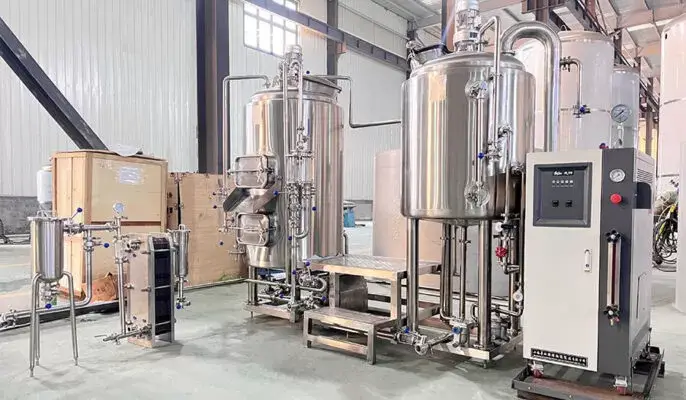
구매 및 운영 고려 사항
적절한 공급업체와 시스템을 선택하려면 다음과 같은 여러 요소를 평가해야 합니다.
| 구매 요인 | 운영 요소 |
|---|---|
| 장비 품질, 신뢰성, 보증 | 에너지 효율성, 운영 비용 |
| 회사의 평판과 경험 | 유지 보수 요구 사항 |
| 맞춤화 기능, 유연성 | 직원 교육이 필요함 |
| 예산 | 청소 절차 및 화학물질 |
| 제조 및 배송 리드타임 | 규정 준수, 검사 |
평가 기준은 개별 양조장의 목표, 재정 및 위험 허용 범위에 따라 달라집니다. 대부분의 목표는 예산 제약 내에서 성능을 최적화합니다.
이 개요에서는 알코올 생산 시설의 일반적인 장비를 다룹니다. 증류주용 증류 시스템이나 와인 제조용 분쇄기 등 다양한 변형과 추가 기능이 존재합니다. Brewers는 알코올 함량, 향미 프로필 및 품질을 테스트하기 위한 품질 관리 실험실과 같은 추가 기능을 통해 추가로 맞춤화할 수 있습니다. 신중한 선택과 작동을 통해 양조 장비를 사용하면 목표량과 비용으로 효율적이고 일관된 알코올 생산이 가능합니다.
올바른 발효 탱크 선택
발효 탱크는 알코올 생산 공정을 제어하는 데 중요한 구성 요소입니다. Brewer는 탱크를 선택할 때 많은 요소를 평가해야 합니다.
탱크 크기 조정
Tiny Titans: Perfect for the curious experimenter, 1-gallon jugs or carboys offer a compact and budget-friendly entry point. Ideal for testing new recipes or crafting personal-sized batches, they fit snugly in kitchens and apartments.
Weekend Warriors: Scaling up to 5-gallon carboys or kettles opens doors to more variety and sharing. This popular size caters to the casual brewer who enjoys sharing their creations with friends and family, offering enough volume for several six-packs without overwhelming your space.
Homebrew Heroes: Stepping into the 10-gallon territory signifies a commitment to the craft. This size allows for multiple smaller batches or larger, single-batch brews, catering to those who enjoy the process as much as the final product. Think weekly brewing sessions or supplying small gatherings.
Small-Scale Stars: For those dreaming of microbrewery-style production, 20-30 gallon kettles and fermenters offer a significant leap. This size caters to ambitious brewers who envision consistent production, supplying local markets, or hosting bigger events. Remember, space and cleaning demands also scale up!
Beyond the Norm: Pushing past the 30-gallon mark signifies serious business. These setups, often modular or stackable, cater to established brewers or aspiring entrepreneurs aiming for larger-scale production and distribution. Be prepared for dedicated brewing spaces and significant investments.
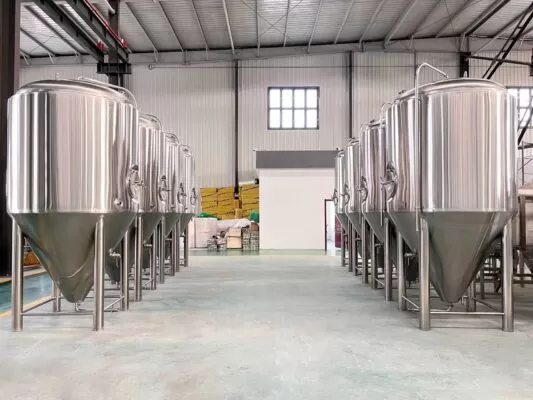
탱크 재료
When it comes to choosing equipment for your alcohol brewing adventures, the tank material plays a crucial role in shaping your experience. Each option boasts unique advantages and drawbacks, and understanding them is key to making an informed decision. Let’s explore the most common contenders:
The King of Durability: Stainless Steel
Reigning supreme in the brewing world, stainless steel stands out for its exceptional durability, resistance to corrosion, and ease of cleaning. It imparts minimal flavor to your creations and withstands the rigors of sanitization and temperature shifts. However, its robustness comes at a premium, making it the pricier option.
Budget-Friendly Choice: Plastic
For cost-conscious brewers, plastic offers a more affordable alternative. Food-grade plastic containers and buckets are perfect for smaller-scale brewing or initial experimentation. However, some plastics can leach chemicals into your brew and might not withstand high temperatures as well as stainless steel. They are also more susceptible to scratches and staining.
The Traditional Touch: Wood
Wooden barrels infuse your creations with unique flavors and textures, adding a touch of history and character to your brews. Oak is the preferred choice for aging spirits like whiskey and cider, while other woods like cherry can complement specific beers. However, wood requires extensive maintenance, is prone to leaks, and can be challenging to clean, making it a niche option for dedicated enthusiasts.
The Glass Advantage: Clarity and Ease of Viewing
For visual observation and small-scale brewing, glass carboys offer undeniable benefits. You can directly witness the fermentation process unfolding, making them ideal for educational purposes or experimenting with new techniques. However, glass is fragile and requires careful handling, making it less suitable for larger setups or frequent use.
Beyond the Norm: Specialized Options
For specific brewing styles or unique needs, you might encounter more specialized materials like aluminum, copper, or even concrete. Each offers distinct advantages and limitations, tailored to specific applications. Researching their suitability for your chosen style is crucial.
온도 제어
Simple Solutions for Casual Brewers:
For small-scale setups or those starting their brewing journey, basic methods like water baths or ice packs offer simple, budget-friendly options. While requiring more manual intervention, they can be effective for maintaining consistent temperatures, especially for styles with less stringent requirements.
Dialing it In: Immersion Chillers and Heating Elements:
These workhorses of temperature control directly interact with your brewing vessel. Immersion chillers use a coil submerged in your wort or fermenter to efficiently cool your brew, while heating elements provide precise temperature control during mashing or boiling. They offer more control than passive methods but require compatible equipment and some technical knowledge.
Automation Takes the Reins: Temperature Controllers:
Elevating your game? Consider a dedicated temperature controller. This handy device acts as the brain of your setup, monitoring and adjusting temperature based on pre-programmed settings. They often pair with immersion chillers or heating elements, automating the process and ensuring consistent results.
The All-in-One Approach: Fermentation Chambers:
For ultimate control and convenience, fermentation chambers take things to the next level. These insulated enclosures house your fermenters and provide precise temperature control, often with programmable profiles for different fermentation stages. While a substantial investment, they offer unparalleled control and consistency, ideal for serious brewers or those venturing into temperature-sensitive styles.
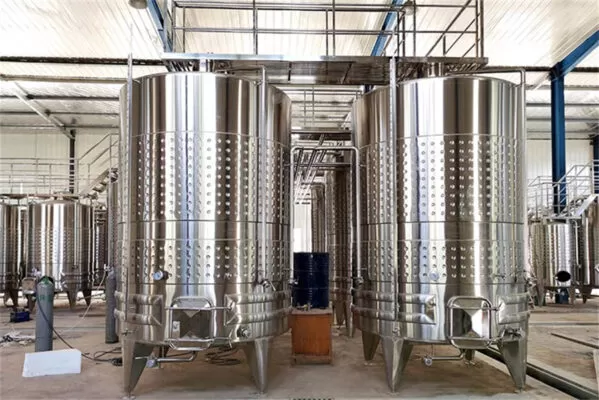
알코올 양조 장비 청소 및 유지 관리
장비와 제품 품질을 유지하기 위해 양조업자는 CIP(Clean-In-Place) 시스템을 사용하여 배치 간 엄격한 세척 절차를 따릅니다.
| 방법 | 기능 | 사용된 화학물질 |
|---|---|---|
| 가성세척 | 유기 잔류물을 제거합니다 | 수산화나트륨, 차아염소산나트륨 |
| 산성 세척 | 스케일 및 광물 침전물 제거 | 질산, 인산 또는 황산 |
| 살균 | 박테리아를 죽입니다 | 이소프로판올, 과산화수소, 오존 |
일일 및 주간 유지보수 점검을 통해 올바른 작동을 보장합니다.
- 탱크와 밸브의 누출 여부를 검사하십시오.
- 온도 센서와 자동화 시스템이 잘 교정되었는지 확인하세요.
- 예상대로 파이프라인 및 펌핑 시스템 흐름을 확인하세요.
- 분석 동향에 대한 로그 검토
- 세척 효능 테스트
청소 및 유지 관리에 대한 모범 사례를 따르면 발효 장비가 수년 동안 지속적으로 최고의 성능을 발휘하는 데 도움이 됩니다.
자주 묻는 질문
| 질문 | 답변 |
|---|---|
| 소규모 양조장을 시작하는 데 가장 중요한 장비는 무엇입니까? | 소규모 양조의 경우 핵심 부품은 양조 주전자, 온도 조절 기능이 있는 발효기 탱크 및 병입 라인입니다. 생산량이 증가하면 나중에 곡물 처리 및 기타 자동화를 추가할 수 있습니다. |
| 장비 배치와 공간에 대해 어떤 요소를 고려해야 합니까? | 장비 크기, 생산 작업 흐름, 인체 공학, 환기, 유틸리티 접근 및 탱크 확장 또는 추가 공간을 고려하십시오. 장비 공급업체나 양조장 컨설턴트로부터 레이아웃 조언을 받으세요. |
| 자동 또는 수동 장비를 선택해야 합니까? | 자동화된 양조장은 대용량 시설의 운영을 단순화합니다. 수동 시스템은 소규모 장인 양조업자에게 유연성과 직접 제어 기능을 제공하면서 비용도 적게 듭니다. 생산 목표, 예산, 직원 역량을 기준으로 장단점을 평가합니다. |




